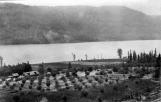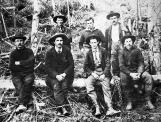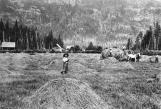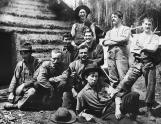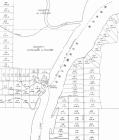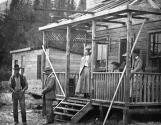14
Little time was lost at Edgewood, and the boat now headed north into an ever narrowing waterway. Passengers seemed a bit puzzled by the distant scene where the mountains appeared to block the lake completely. Fred who had gone for coffee was startled by the sound of the steam whistle, coming so quickly. The boat was pulling into Needles. When the Columbia Valley Land Co. obtained title to land in the Whatshan Valley high above Needles, about forty families moved in to start farming. Seen as a bit of a scam due to the fact that the soil was rocky and lacking a good supply of water, this venture was a questionable endeavor.Fred learned that Joe Crowell of Nakusp, who was agent for CVL Co. was pushing for a store to be built at their waterfront property of Needles. Puzzled by the odd name given the landing, he later was told this referred to a couple of spits of land that projected out into the lake.
16
Directly across from Needles lay a newly named district called Fauquier. Originally made up of pre-emptions, it had now been purchased by former Nakusp policeman, Fred Fauquier. After starting a large farm of his own, he sold titles to others eager to get in the orchard business.Fred Fauquier had been the Gold Commissioner at Revelstoke. When a $30,000.00 shipment of cash was shipped in for him to distribute to miners bringing in gold, it was placed in the safe for security. One day the money went missing. About a year later Fauquier moved to this new settlement, quite flush and able to make the land purchase as well as erect several buildings. Would the truth ever be known?
18
Since Fred had made this journey before, he wasn't surprised by the extreme narrowing of the channel that was now moving in a northeast direction. The current, which was almost river-like, washed heavily against the Minto's bow. Under these conditions, a mate was sent up to the wheelhouse to assist the captain with the wheel in an effort to dodge the sand bars, dead heads and rock bluffs they encountered. After several minutes of jostling, the lines were thrown out and the boat was pressed tightly against the Burton wharf.There was a deep valley, east of Burton with high mountains that were still being explored by prospectors and active with miners. On the flat, both farming and logging could be seen to be expanding more rapidly than ever.
20
A widening of the valley and broadening of the lake reinforced one's view of the reality of major land sales expected in the region. Very gently sloping shores merged into massive mountains and after a great distance the offering was not only good gradient but well composted soil.On the west side, the land was originally pre-empted by Captain Vanderburgh in 1890 but when he was drowned in 1895, the property was sold to Miles Yingling. A.J. Graham, the first man to own land at Brouse, near Nakusp, joined Yingling by purchasing another parcel there. Graham was the man whose name was given by the CPR to the boat landing. Massive timber made clearing extremely exhausting but also lucrative in sales of logs and poles. Very slowly, families were arriving but because there was no land company involved here, the pace wasn't as brisk.
22
Directly across from Grahams Landing - the west side of the lake - sat another steamer stop named Carrolls landing. Folks like the Halls, Moseleys and Green families were eking out a living at this time but barely surviving in the poor conditions. Mostly from the UK, they were lured out by ads by land companies that misrepresented this real estate dramatically. Maps showed roads, parks, school sites, wharves and commercial centers that never really existed. The steamer would just pull up to the beach, unload the newcomers along with their belongings and sail away. It was pitch a tent, find your lot in a wild forest and start working.Miles Carroll, a ship's carpenter from Nakusp was one of the first to stake a place at this location and consequently it took this name from then on. Old already in 1908, Miles failed to put much time into the farm, preferring rather, to live in a little log cabin in Nakusp.
Similarly, but this time on the east side of the lake, Tom Makinson secured a pre-emption about 18 miles (29 km) south of Nakusp choosing to build a house out of lumber from the wrecking of the Sternwheeler, Lytton. Very much like the rest of Arrow lakes property, Tom was sure he could eventually make it into a dream farm.
All the passengers along with Fred had had a taste of swift water at Burton, now as they approached what looked like a dead end there was some concern over what lay ahead. Before that water was to be negotiated the Minto started heading for shore.
Very little was happening on the east shore, but the west side had been subjected to massive clearing. It was learned that Kootenay Orchard Association of Nelson (owned by Hammond Brothers of Winnipeg) had conducted a huge survey on each side, consequently parcels of about 10 acres (4.05 hectares) each, were now being made available to the public. It was good flat land and sub-irrigated with good sunlight on the west side, although the east abutted a high mountain. Arrow Park was the given name for the area, creating a dilemma because the lake separated the two halves. So the side abutting the mountain was called East Arrow Park.
Arrow Park proper was the entrance way to a large valley that ran parallel to the Arrow Lakes. Too massive to be considered for farm land, its real value would come from its huge timber resource, a fact that would ring true in the decades to come. Young men eager to work and for low pay, often had to travel hundreds of miles for a month's employment. Constantly on the move, their clothes tattered, hair cut by a friend and sweat marks on their hats, the men were thankful for any opportunity to get a start in life so they could get married and settle down.

